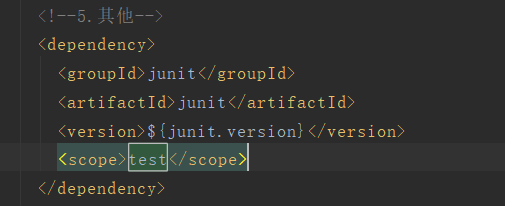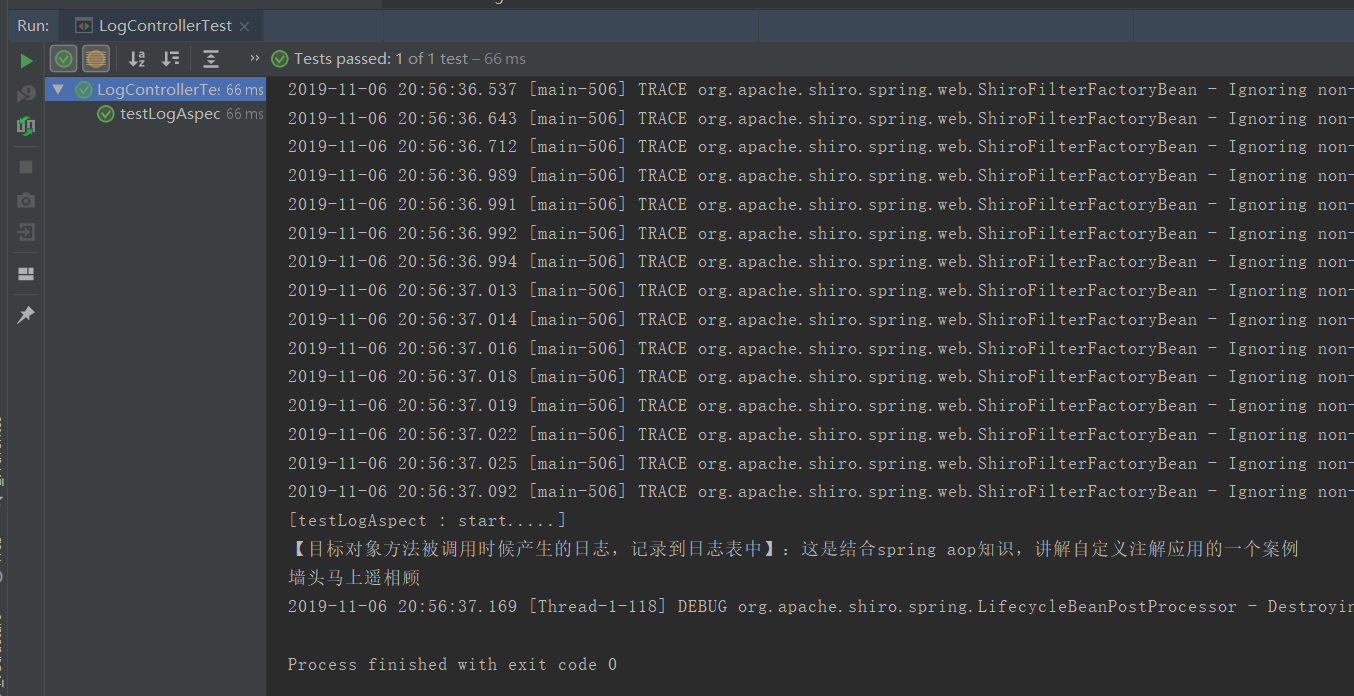java之aop使用及自定义注解
目的:
1.Java注解简介
2.Java元注解(重点)
3.自定义注解
4.Aop自定义注解的应用(重点)
Java注解简介
1. Java注解(Annotation)
Java注解是附加在代码中的一些元信息,用于一些工具在编译、
运行时进行解析和使用,起到说明、配置的功能。
注解相关类都包含在java.lang.annotation包中。
2. Java注解分类
2.1 JDK基本注解
2.2 JDK元注解
2.3 自定义注解
3. JDK基本注解
3.1 @Override
重写
3.2 @Deprecated
已过时
3.3 @SuppressWarnings(value = "unchecked")
压制编辑器警告
Java元注解
作用:元注解用于修饰其他的注解
- @Retention:定义注解的保留策略
@Retention(RetentionPolicy.SOURCE) //注解仅存在于源码中,在class字节码文件中不包含
@Retention(RetentionPolicy.CLASS) //默认的保留策略,注解会在class字节码文件中存在,但运行时无法获得,
@Retention(RetentionPolicy.RUNTIME) //注解会在class字节码文件中存在,在运行时可以通过反射获取到
@Target:指定被修饰的Annotation可以放置的位置(被修饰的目标)
@Target(ElementType.TYPE) //接口、类
@Target(ElementType.FIELD) //属性
@Target(ElementType.METHOD) //方法
@Target(ElementType.PARAMETER) //方法参数
@Target(ElementType.CONSTRUCTOR) //构造函数
@Target(ElementType.LOCAL_VARIABLE) //局部变量
@Target(ElementType.ANNOTATION_TYPE) //注解
@Target(ElementType.PACKAGE) //包
注:可以指定多个位置,例如:
@Target({ElementType.METHOD, ElementType.TYPE}),也就是此注解可以在方法和类上面使用
- @Inherited:指定被修饰的Annotation将具有继承性
@Documented:指定被修饰的该Annotation可以被javadoc工具提取成文档.
自定义注解
注解分类(根据Annotation是否包含成员变量,可以把Annotation分为两类):
标记Annotation:
没有成员变量的Annotation; 这种Annotation仅利用自身的存在与否来提供信息
元数据Annotation:
包含成员变量的Annotation; 它们可以接受(和提供)更多的元数据;
如何自定义注解?
使用@interface关键字, 其定义过程与定义接口非常类似, 需要注意的是:
Annotation的成员变量在Annotation定义中是以无参的方法形式来声明的, 其方法名和返回值类型定义了该成员变量的名字和类型,
而且我们还可以使用default关键字为这个成员变量设定默认值;
注意:只有名字为“value”属性,赋值时可以省略属性名
案例一(获取类与方法上的注解值):
TranscationModel
package com.huangting.annotation.P1;
/**
* enum枚举
*/
public enum TranscationModel {
Read, ReadWrite, Write
}
MyAnnotation1
package com.huangting.annotation.P1; import java.lang.annotation.*; /**
* MyAnnotation1注解可以用在类、接口、属性、方法上
* 注解运行期也保留
* 不可继承
*/
@Target({ElementType.TYPE, ElementType.FIELD,ElementType.METHOD})
@Retention(RetentionPolicy.RUNTIME)
@Documented
public @interface MyAnnotation1 {
String name();
}
MyAnnotation2
package com.huangting.annotation.P1; import java.lang.annotation.*; /**
* MyAnnotation2注解可以用在方法上
* 注解运行期也保留
* 不可继承
*/
@Target(ElementType.METHOD)
@Retention(RetentionPolicy.RUNTIME)
@Documented
public @interface MyAnnotation2 {
TranscationModel model() default TranscationModel.ReadWrite;
}
MyAnnotation3
package com.huangting.annotation.P1; import java.lang.annotation.*; /**
* MyAnnotation3注解可以用在方法上
* 注解运行期也保留
* 可继承
*/
@Target(ElementType.METHOD)
@Retention(RetentionPolicy.RUNTIME)
@Inherited
@Documented
public @interface MyAnnotation3 {
TranscationModel[] models() default TranscationModel.ReadWrite;
}
Dome1
package com.huangting.annotation.P1; /**
* 获取类与方法上的注解值
*/
@MyAnnotation1(name = "abc")
public class Demo1 { @MyAnnotation1(name = "xyz")
private Integer age; @MyAnnotation2(model = TranscationModel.Read)
public void list() {
System.out.println("list");
} @MyAnnotation3(models = {TranscationModel.Read, TranscationModel.Write})
public void edit() {
System.out.println("edit");
}
}
Demo1Test
package com.huangting.annotation.P1;
import org.junit.Test;
public class Demo1Test {
@Test
public void list() throws Exception {
// 获取类上的注解
MyAnnotation1 annotation1 = Demo1.class.getAnnotation(MyAnnotation1.class);
System.out.println(annotation1.name());//abc // 获取方法上的注解
MyAnnotation2 myAnnotation2 = Demo1.class.getMethod("list").getAnnotation(MyAnnotation2.class);
System.out.println(myAnnotation2.model());//Read
} @Test
public void edit() throws Exception {
MyAnnotation3 myAnnotation3 = Demo1.class.getMethod("edit").getAnnotation(MyAnnotation3.class);
for (TranscationModel model : myAnnotation3.models()) {
System.out.println(model);//Read,Write
}
}
}
效果:

注意:
jar包的运用中最好不要出现test,把《scope》《/scope》删除即可

否则会报错@Test无法使用

案例二(获取类属性上的注解属性值)
TestAnnotation
package com.huangting.annotation.P2; import java.lang.annotation.ElementType;
import java.lang.annotation.Retention;
import java.lang.annotation.RetentionPolicy;
import java.lang.annotation.Target; //@Retention(RetentionPolicy.SOURCE)
@Retention(RetentionPolicy.RUNTIME)
@Target(ElementType.FIELD)
public @interface TestAnnotation {
String value() default "默认value值";
String what() default "这里是默认的what属性对应的值";
}
Dome2
package com.huangting.annotation.P2; /**
* 获取类属性上的注解属性值
*/
public class Demo2 {
@TestAnnotation(value = "这就是value对应的值_msg1", what = "这就是what对应的值_msg1")
private static String msg1; @TestAnnotation("这就是value对应的值1")
private static String msg2; @TestAnnotation(value = "这就是value对应的值2")
private static String msg3; @TestAnnotation(what = "这就是what对应的值")
private static String msg4;
}
Demo2Test
package com.huangting.annotation.P2;
import org.junit.Test;
public class Demo2Test {
@Test
public void test1() throws Exception {
TestAnnotation msg1 = Demo2.class.getDeclaredField("msg1").getAnnotation(TestAnnotation.class);
System.out.println(msg1.value());
System.out.println(msg1.what());
}
@Test
public void test2() throws Exception{
TestAnnotation msg2 = Demo2.class.getDeclaredField("msg2").getAnnotation(TestAnnotation.class);
System.out.println(msg2.value());
System.out.println(msg2.what());
}
@Test
public void test3() throws Exception{
TestAnnotation msg3 = Demo2.class.getDeclaredField("msg3").getAnnotation(TestAnnotation.class);
System.out.println(msg3.value());
System.out.println(msg3.what());
}
@Test
public void test4() throws Exception{
TestAnnotation msg4 = Demo2.class.getDeclaredField("msg4").getAnnotation(TestAnnotation.class);
System.out.println(msg4.value());
System.out.println(msg4.what());
}
}
效果:

案例三(获取参数修饰注解对应的属性值):
IsNotNull
package com.huangting.annotation.P3; import java.lang.annotation.*; /**
* 非空注解:使用在方法的参数上,false表示此参数可以为空,true不能为空
*/
@Documented
@Target({ElementType.PARAMETER})
@Retention(RetentionPolicy.RUNTIME)
public @interface IsNotNull {
boolean value() default false;
}
Demo3
package com.huangting.annotation.P3; /**
* 获取参数修饰注解对应的属性值
*/
public class Demo3 { public void hello1(@IsNotNull(true) String name) {
System.out.println("hello:" + name);
} public void hello2(@IsNotNull String name) {
System.out.println("hello:" + name);
}
}
Demo3Test
package com.huangting.annotation.P3;
import org.junit.Test;
import java.lang.reflect.Parameter;
public class Demo3Test { @Test
public void hello1() throws Exception {
Demo3 demo3 = new Demo3();
for (Parameter parameter : demo3.getClass().getMethod("hello1", String.class).getParameters()) {
IsNotNull annotation = parameter.getAnnotation(IsNotNull.class);
if(annotation != null){
System.out.println(annotation.value());//true
}
}
} @Test
public void hello2() throws Exception {
Demo3 demo3 = new Demo3();
for (Parameter parameter : demo3.getClass().getMethod("hello2", String.class).getParameters()) {
IsNotNull annotation = parameter.getAnnotation(IsNotNull.class);
if(annotation != null){
System.out.println(annotation.value());//false
}
}
}
}
效果:

Aop自定义注解的应用
MyLog
package com.huangting.annotation.Aop; import java.lang.annotation.ElementType;
import java.lang.annotation.Retention;
import java.lang.annotation.RetentionPolicy;
import java.lang.annotation.Target; @Target(ElementType.METHOD)
@Retention(RetentionPolicy.RUNTIME)
public @interface MyLog {
String desc();
}
MyLogAspect
package com.huangting.annotation.Aop;
import org.aspectj.lang.JoinPoint;
import org.aspectj.lang.annotation.Aspect;
import org.aspectj.lang.annotation.Before;
import org.aspectj.lang.annotation.Pointcut;
import org.aspectj.lang.reflect.MethodSignature;
import org.slf4j.Logger;
import org.slf4j.LoggerFactory;
import org.springframework.stereotype.Component; @Component
@Aspect
public class MyLogAspect {
private static final Logger logger = LoggerFactory.getLogger(MyLogAspect.class); /**
* 只要用到了com.huangting.annotation.Aop.MyLog这个注解的,就是目标类
*/
@Pointcut("@annotation(com.huangting.annotation.Aop.MyLog)")
private void MyValid() {
} @Before("MyValid()")
public void before(JoinPoint joinPoint) {
MethodSignature signature = (MethodSignature) joinPoint.getSignature();
MyLog myLog = signature.getMethod().getAnnotation(MyLog.class);
System.out.println("[" + signature.getName() + " : start.....]");
System.out.println("【目标对象方法被调用时候产生的日志,记录到日志表中】:"+myLog.desc());
}
}
BaseTestCase
package com.huangting.annotation.Aop; import org.junit.runner.RunWith;
import org.springframework.test.context.ContextConfiguration;
import org.springframework.test.context.junit4.SpringJUnit4ClassRunner; @RunWith(SpringJUnit4ClassRunner.class)
@ContextConfiguration(locations={"classpath:applicationContext.xml"})
public class BaseTestCase { }
LogController
package com.huangting.annotation.Aop; import org.springframework.stereotype.Component; @Component
public class LogController { @MyLog(desc = "这是结合spring aop知识,讲解自定义注解应用的一个案例")
public void testLogAspect(){
System.out.println("墙头马上遥相顾");
}
}
LogControllerTest
package com.huangting.annotation.Aop; import org.junit.Test;
import org.springframework.beans.factory.annotation.Autowired; public class LogControllerTest extends BaseTestCase {
@Autowired
private LogController logController; @Test
public void testLogAspect(){
logController.testLogAspect();
}
}
效果:

谢谢观看!
java之aop使用及自定义注解的更多相关文章
- AOP中获取自定义注解的参数值
目录 一.利用注解实现AOP的基本流程 1.1.创建一个注解,用来注解切点(pointcut) 1.2.创建一个service,使用上面定义的注解来指定切点 1.3.创建Aspect,增加业务逻辑 ...
- [Java]利用拦截器和自定义注解做登录以及权限验证
1.自定义注解 需要验证登录的注解 package com.etaofinance.wap.common; import java.lang.annotation.Documented; import ...
- 利用Spring AOP自定义注解解决日志和签名校验
转载:http://www.cnblogs.com/shipengzhi/articles/2716004.html 一.需解决的问题 部分API有签名参数(signature),Passport首先 ...
- (转)利用Spring AOP自定义注解解决日志和签名校验
一.需解决的问题 部分API有签名参数(signature),Passport首先对签名进行校验,校验通过才会执行实现方法. 第一种实现方式(Origin):在需要签名校验的接口里写校验的代码,例如: ...
- Spring Boot系列——AOP配自定义注解的最佳实践
AOP(Aspect Oriented Programming),即面向切面编程,是Spring框架的大杀器之一. 首先,我声明下,我不是来系统介绍什么是AOP,更不是照本宣科讲解什么是连接点.切面. ...
- aop 拦截含有特定注解的类
1.功能点:使用aop拦截含有自定义注解的类 1.自定义注解 package com.zhuanche.common.dingdingsync; import java.lang.annotation ...
- 服务限流 -- 自定义注解基于RateLimiter实现接口限流
1. 令牌桶限流算法 令牌桶会以一个恒定的速率向固定容量大小桶中放入令牌,当有浏览来时取走一个或者多个令牌,当发生高并发情况下拿到令牌的执行业务逻辑,没有获取到令牌的就会丢弃获取服务降级处理,提示一个 ...
- 170313、poi:采用自定义注解的方式导入、导出excel(这种方式比较好扩展)
步骤一.自定义注解 步骤二.写Excel泛型工具类 步骤三.在需要导出excel的类属相上加上自定义注解,并设置 步骤四.写service,controller 步骤一:自定义注解 import ja ...
- Spring实现自定义注解并且配置拦截器进行拦截
有时候我们会自定义注解,并且需要配置拦截器对请求方法含有该自定义注解的方法进行拦截操作 自定义注解类 NeedToken.java import java.lang.annotation.Docume ...
随机推荐
- PathVariable传过来的中文乱码是怎么回事
今天在写一个spring mvc程序,由于客户原来设计的原因,不能传id过来,只能传名称,结果发现收到的数据是乱码. 百度之后,找到别人的解决方案,试了下没问题,转载一下.使用的web服务器是Tomc ...
- GRU和LSTM比较
比较: https://www.jianshu.com/p/3774d46b665e https://blog.csdn.net/sinat_33741547/article/details/8282 ...
- Tosca user space 这是自己的空间,可以create module ,test case 等一大堆模块,五脏俱全
- git如何将旧commit的相关notes复制到新commit?
答: git notes copy <old-commit> <new-commit>
- ISO/IEC 9899:2011 条款6.7.4——函数说明符
6.7.4 函数说明符 语法 1.function-specifier: inline _Noreturn 约束 2.函数说明符应该只能被用在对一个函数标识符的声明中. 3.对一个含有外部连接函数的内 ...
- IDEA Git 修改后的文件无法Commit
转自:https://blog.csdn.net/moneyshi/article/details/81298861 因对IDEA使用不熟,在使用和配置GIT的时候,可能哪里配置错误,导致我一直无法使 ...
- ES6深入浅出-10 ES6新增的数据类型-3.其他类型
Map类型 Map 类型 https://developer.mozilla.org/zh-CN/docs/Web/JavaScript/Reference/Global_Objects/Map Ma ...
- 算法习题---5-1代码对齐(UVa1593)
一:题目 将不规范的若干行代码进行对齐.对齐按照最长字符串进行操作.见样例输入 (一)样例输入 ␣␣start:␣␣integer;␣␣␣␣//␣begins␣here stop:␣integer;␣ ...
- React错误收集
1. Uncaught Error: Element type is invalid: expected a string (for built-in components) or a class/ ...
- [译]如何在GitHub仓库创建一个标签tag, 并推送到远程分支?
问: 我在GitHub上有一个仓库,我需要给他打个tag.我在shell打了tag,但是在Github上没有显示出来.我还要做其他什么么? 我在shell中使用的命令是: git tag 2.0 当我 ...
